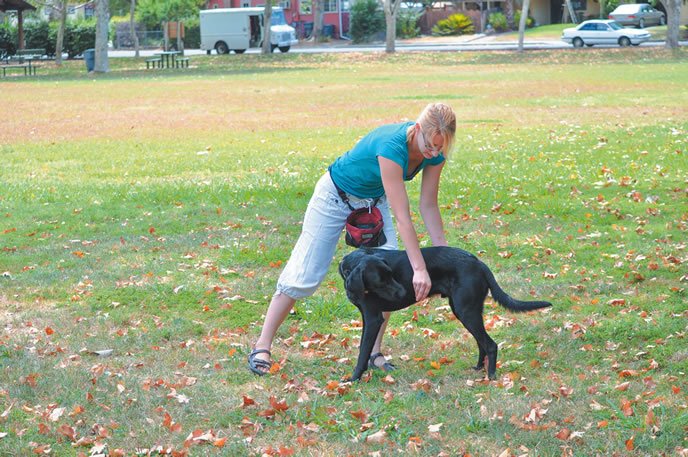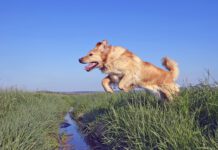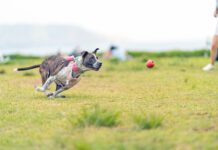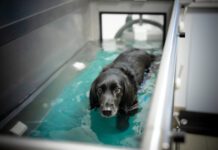[Updated August 9, 2017]

Professional human athletes never skip a proper warmup. That’s because research has proven, repeatedly, that preparing your muscles for upcoming physical activity reduces the risk of physical injury. And for them, an injury could impact their wallet with down time.
Actually, an injury to our dog could impact our wallets, too, translating into veterinary bills. More importantly, it means down time for our canine pal, so we don’t want him to overindulge in activity he isn’t physically ready to perform.
Note: We are assuming your dog is properly conditioned for the task at hand. If your dog isn’t physically fit, the warmup alone could even be too much for him. Fatigue can also result in injuries. Watch for limping, avoidance, loss of interest, cringing when you touch him, and excessive panting. It’s important to know when your dog has had enough and stop. If you’re not sure how hard your dog can exercise, talk with your veterinarian or a professional trainer.
Warm Up Your Dog Before Exercise
Consider how most dogs spend their days while you’re at work. Whether inside or out, they’re rarely active. They’re waiting for you to return home. Sure, they might mosey on over to the water bowl, but then they’ll flop down and continue to wait. It’s even worse if you have to keep your dog in a crate or kennel for more than a few hours.
This long period of inactivity causes cold and contracted muscles. Unprepared for activity, a cold muscle is more easily injured – and recovery can take six weeks or more of inactivity, during which time more fitness can be lost. A warm muscle is ready to stretch and support.
Of course, warm muscles can be injured, too, but it’s still wise to get your dog’s “muscle motor” going before engaging in strenuous activity. A warmup increases the heart rate, which generates greater circulation, which delivers more oxygen to the muscles. As his muscles warm and lengthen, they become more pliable, ready to flex, bend, and move. He’ll be alert physically and mentally, whether it’s playing just fetch or practicing a disc dog routine for competition.
If all you’re going to do is take your dog for a long walk, the warmup might be walking slowly for two or three minutes. In fact, nearly every warmup (for any sport) should begin with five to 10 minutes of walking. Toward the end of the period, you can start ramping things up a bit, depending upon what you plan to do with your dog.
“Warmup routines need to vary for the level of exertion expected of the dog. All dogs who compete should start off with at least a few minutes of walking, especially if they had been crated,” says Andrea Lee, MS, DVM, of Syracuse, New York, an owner and trainer of Brittanys with conformation and agility championships. “My warmup routine depends on the age of the dog and the dog’s orthopedic history. My older dog who has had multiple stifle injuries and whose back sometimes gets sore receives the most extensive warmup (and cooldown). I will take her through five minutes of walking, followed by two to three minutes of trotting and a few sprints – actually, recalls or else I have to sprint with her! Then I use some active stretching.”
Active stretches, not static stretches, are acceptable for warmups. The term “active stretching” means the dog is doing the muscle stretching, not the person, such as the dog reaching forward for a treat, stretching his back. Your dog isn’t likely to stretch himself beyond his comfort zone.
A “static stretch,” on the other hand, is when the person stretches the dog’s muscles, such as by pulling gently on a hind leg. Static stretches can damage cold muscles and should only be used during the after-activity cooldown (more on that below).
“I use warmup stretches with my dog with the orthopedic history, but prefer to do active stretches so that the muscles are not overstretched if the dog is not warm enough yet. I usually do these with something yummy the dog can lick, and these stretches mostly involve the spine and neck because when she runs, she hyperextends her back,” Dr. Lee says.
Timing your warmup is important because as soon as the dog stops moving, his muscles begin to cool and contract. Schedule your warmup for no more than 20 or 30 minutes prior to the activity.
“To keep my dog warm while waiting for her turn in the ring, we walk and practice some of her old rehab moves, mostly moving backward and side-stepping,” Dr. Lee says. “My goal is to have her lightly panting when we are ready to start.”
Tailor your warmup to the activity at hand. If you’re competing in a sport that requires jumping, like agility, you’ll want to include some warmup jumps before entering the ring. If you’re doing lure coursing, you’ll want to include some increasingly fast running. Disc dog? Be sure you have your dog do some turns, circles, and hip exercises.
“My younger dogs get walked for at least five minutes, then outside the ring, we do hand touches alternating sides so they have to bounce back and forth. We also spin right and left and practice heeling,” Dr. Lee says. “When I did obedience, we practiced lots of heeling outside the ring, not only to warm up the dog, but also to hopefully gain her focus.”
Cooling Down After a Work Out
Just as important to your dog’s athletic health is what you do with your dog after her intense exercise.
As we said earlier, muscular cooldown and contraction begins as soon as your dog stops working. Post activity, chances are his heart and respiratory rates are still high, and he may be panting. If your dog’s been running, just slow to a normal walk and gradually allow the dog to slow further. The cooldown period can be as little as five minutes; just watch for signs your dog is returning to normal. For example, her panting should slow down, slow down some more, and unless it’s hot outside, she should begin to breathe with her mouth closed. Offer her some fresh, cool water to keep her hydrated, and then you can start some gentle massage.
Describing how to do static stretches is beyond the scope of this article, but if you already do static stretches on your dog’s front legs/shoulders and rear legs/hips, make sure you attempt these only during this cooldown phase, when the dog’s muscles are warm and fully pliable. Always use gentle, steady pressure, staying within the dog’s comfort level. If he objects, you are pulling too hard or in an improper direction. It’s wise to work with an experienced person the first time you use these stretches, as you can cause harm, too. Remember that you’re not just influencing the limb you manipulate; consider all the muscles, tendons, and joints that are connected to it, as well.
“I do stretches as part of a cooldown for my dog with the orthopedic history. I do brisk walking, then normal paced walking, then slower walking, then massage and active stretching. My younger dogs just get a walk. I do not want them to be panting heavily when they are placed in the crate after an agility run,” says Dr. Lee.
Keep the ambient temperature in mind, too, when your dog completes exercise. If it’s very warm out, you may want to use a little water to help cool your dog (see “How to Prevent Heat Stroke in Dogs,” WDJ July 2015). If it’s cold, you may want to put a coat on your dog prevent a too-rapid cooling of the muscles, which could cause cramps.
Improve Your Dog’s Athletic Performance!
Research has repeatedly shown that warmup and cooldown sessions improve athletic performance. Equestrians have been long-time proponents of warming up and cooling down their horses. When I learned to ride, we were taught that every ride started and ended with a 10-minute walk, followed by walking the horse by hand until he was completely cool. For many dog owners it can be just as simple.
“For pet owners whose dogs like to play, I’d recommend starting off with some leash walking prior to hard play.,” Dr. Lee says. “If the dog loves fetch, start with some shorter, lower tosses and build up to the longer, higher throws. Reverse for the cooldown.”
Take the time and care to provide simple, effective, and healthy procedures, tailored for your dog’s activity level. Compared to a painful injury, expensive treatment, and lengthy rehabilitation, it’s worth the small investment of time.
Cynthia Foley is an active horsewoman and agility-dog competitor in upstate New York.




